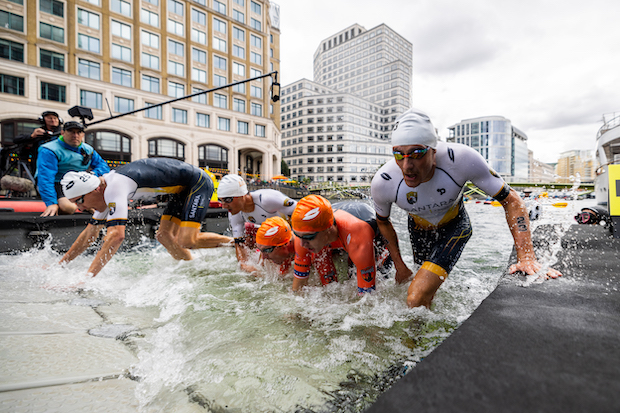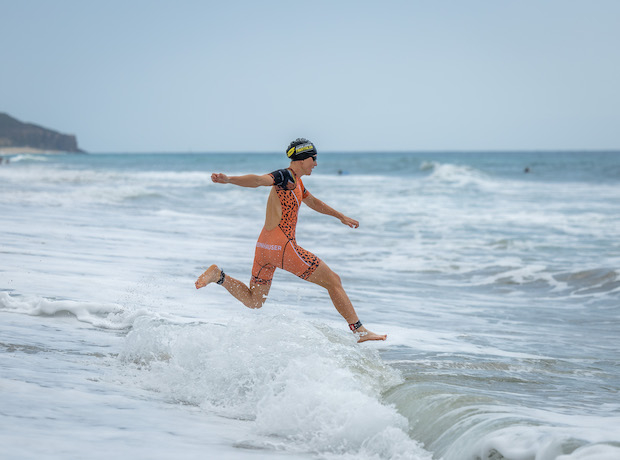Behind the Scenes of Racing Super League

When you think triathlon, most people’s thoughts go to long distance racing. Long course racing is inspiring, with tales of overcoming adversity and feats of human endurance. But in reality, how many non-triathletes are sitting down and watching a full or half distance race from start to finish? Or even the highlight reel? Yes, to someone deeply involved in the sport, its highly entertaining, but outside of that? Is triathlon capable of becoming a spectator sport? For me, I think Super League has the best chance of becoming a series that people want to watch.
I raced in Super League’s Championship Series in 2018, 2019, and made a guest appearance in this year’s Toulouse race. Though I was never a top contender, this continues to be one of my favorite styles of racing. It’s fast. It's technical. It’s chaos. It’s unlike other triathlon events out there due to their unusual formats and distances.
The courses are tight and technical with features like tight chicanes, cobbles, or off-camber corners. Crashes happen, as evidenced by the viral clips on social media. Are these courses inherently dangerous? In my opinion, no, but I wouldn’t be putting young or inexperienced athletes on them either. These courses are for professional athletes, and you need to have professional-level bike handling in order to ride them. Neither fans nor athletes want to just roll around the course. The technical sections make racing fun, and incorporating features makes for great racing and spectating.
This year is the fifth year of Super League’s Championship Series. Super League has changed over the years, finding their footing with race formats, rules, and teams. The evolving rules, I think, come with experience and discovering what works well and what doesn’t. For example, watching athletes absolutely destroy the bottoms of their feet by running the run courses barefoot, to save vital seconds through transitions leading to shoe rules. With the team aspect, I was initially unsure of the decision (Cheetahs? Rhinos?), but I think this year they’ve done a better job of it. Trying to follow the model of Formula 1 racing, they’ve brought in team sponsors and managers. From an athlete perspective, it brings an additional sense of comradery having teammates. That and it makes the swim less of an all-out fist fight, at least to start. Still, I have a few memorable swim experiences from Super League races in the earlier years. Considering the first turn buoy is often around 100m from the race start, you can’t blame people for having their claws out.
How it Works

There are both individual and team components to racing. Athletes finishing in the top 15 will earn points for their respective teams. Extra points are on offer at the season finale in Neom, Saudi Arabia. Athletes can also earn additional points for clocking one of the top fastest swim, bike, or run times.
During the race, athletes can earn shortcuts, or “short chutes”, for their team to use in a later stage. These give an athlete the advantage of taking a shorter run distance in the final stage of the event. Short chutes are given to the first athletes to cross various points of the course. Which athlete gets to use the short chute from the team is up to the team manager. Once the short chute is assigned it can’t be changed, meaning the Team Managers must choose wisely when making decisions for the team.
There are various ways athletes can make money. Athletes finishing in the top 10 at each race, as well as finishing top 10 in the overall season ranking will earn prize money. The individual rankings and overall season rankings are decided by an athlete’s two best results from the first three events (London, Toulouse, Malibu), plus their results from the Championship final in Neom. Team scores accumulate over the course of the season, determining the finishing order of the teams and their share of the $300,000 team purse prize.
In addition, at the end of the season, each discipline leader: swim, bike, and run, will also earn $15,000 for their efforts.
In total, it’s around 1.24 million dollars available in prize money over the season. Making this series a viable career option for short course athletes. With that type of cash available, it's a purse that could pull athlete’s towards becoming Super League specialists, and away from World Triathlon racing all together.
I, for one, want to see the series keep growing. The events feel very professional, from branding, to scheduling, to how they treat their athletes. They also do a great job of community involvement: conducting school visits, putting on swim clinics for kids, meeting with local officials. They’re able to gain support in the local community and draws large crowds on race day.
What to Expect in Malibu

As I write this, it’s up in the air as to whether the Malibu event will take place. A small, endangered fish called a tidewater goby has made its home on part of the event course. Because the event is only a few days away, race organizers have been unable to obtain permits to devise an alternative race route. So far, all appeals from race organizers have been rejected. A final verdict is expected to be delivered early next week.
For those who’ve never watched a race, I urge you to watch one. The races consist of various formats of super-sprint distance swims, bikes, and runs. Formats have prominent names like The Enduro or Triple Mix.
With most athletes racing the Grand Final in Pontevedra, it will be interesting to see who can handle the cross-Atlantic travel and recovery. Considering Pontevedra is an Olympic qualifier for several countries, including the US, some athletes are sure to mentally turn off after a WTCS season that started in early March.
The race will be home race for the Warriors team, which boasts an all American lineup. Hoping to gain back points on home soil, the Warriors have employed unconventional race tactics in the past to stay competitive. With a full roster, and whispers of including an American Ironman recordholder, they will be grasping for every point possible.
The race itself will be Eliminator Format: Three rounds of 300m swim, 4km bike, and 1.6km run with a short break in between. The total times from stages 1 and 2 combine to determine the pursuit start times for Stage 3. The athlete that crosses the line first of stage three is the winner. As in all Super League events, athletes that fall 90 seconds back from the leader at any point are eliminated. So, if an athlete loses by 45 seconds on the first round, and 50 on the second, they are eliminated and not able to start round three.
The surf will definitely be a factor. We saw at the race last year that an athlete’s ability to catch a wave can create huge gaps out of the water. “Huge” being a relative term, but to put things in perspective 30 seconds could be the difference between first and fourteenth place in a round. The bike course is punchy with athletes needing to push lots of power out of tight corners to stay in the race. On the run, athletes will need to be able to accelerate out of 180 degree turns to keep their speed.
If anything is known about this race, it’s that there will be drama. Whether it be from team tactics, crashes, impressive skills, or a flustered team manager yelling from the sidelines, it’s bound to be entertaining.
Watch Super League Malibu on Saturday, September 30th here.
Images Courtesy of Super League


Start the discussion at slowtwitch.northend.network